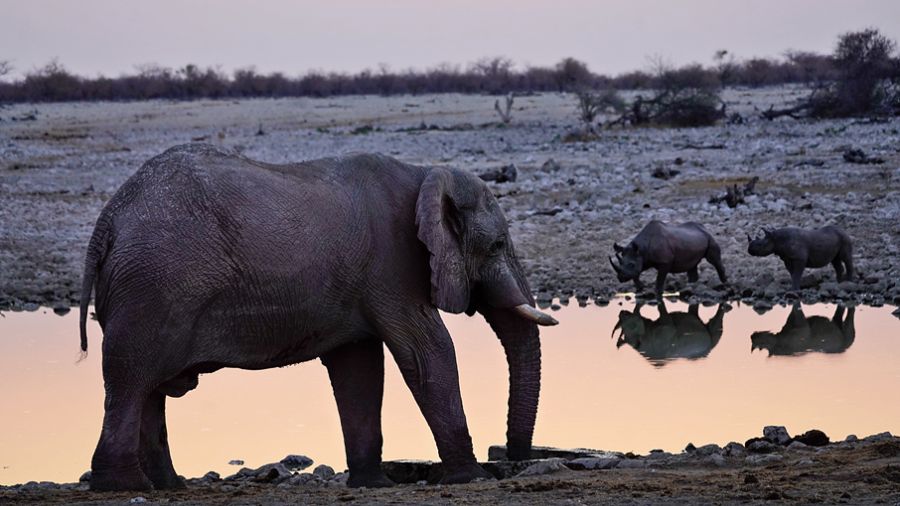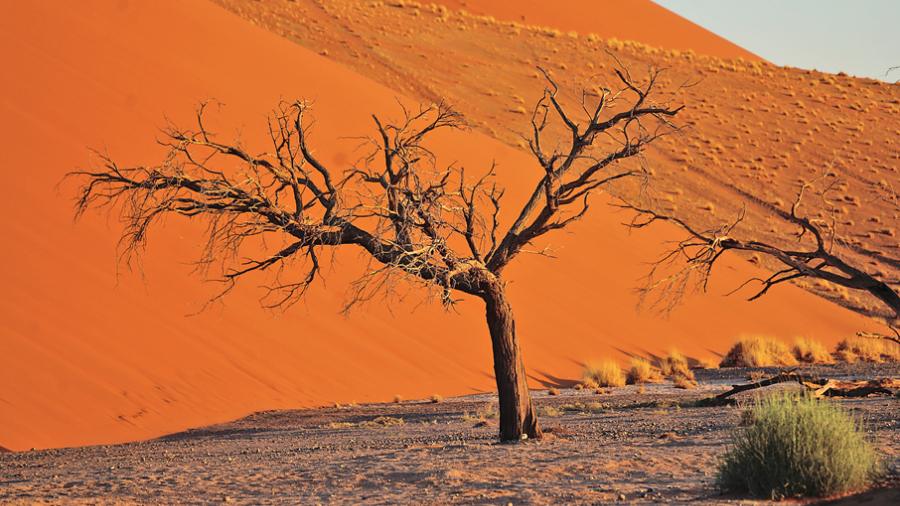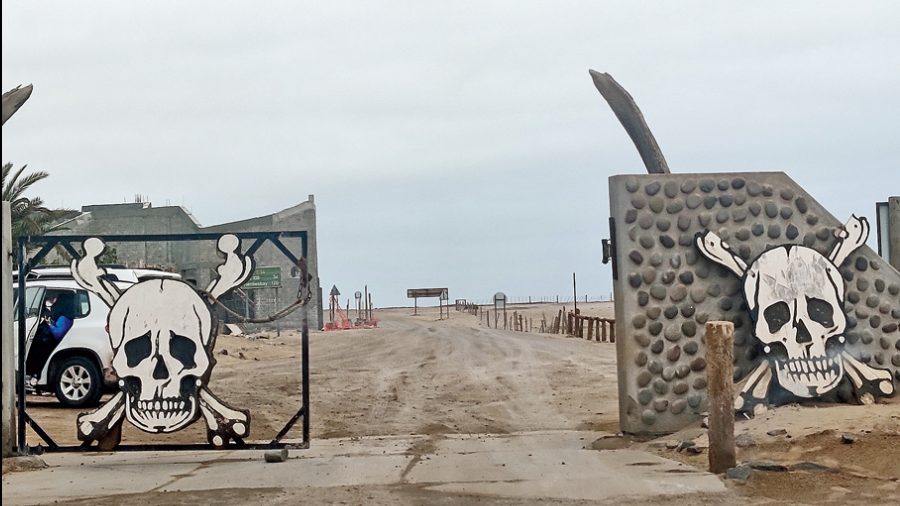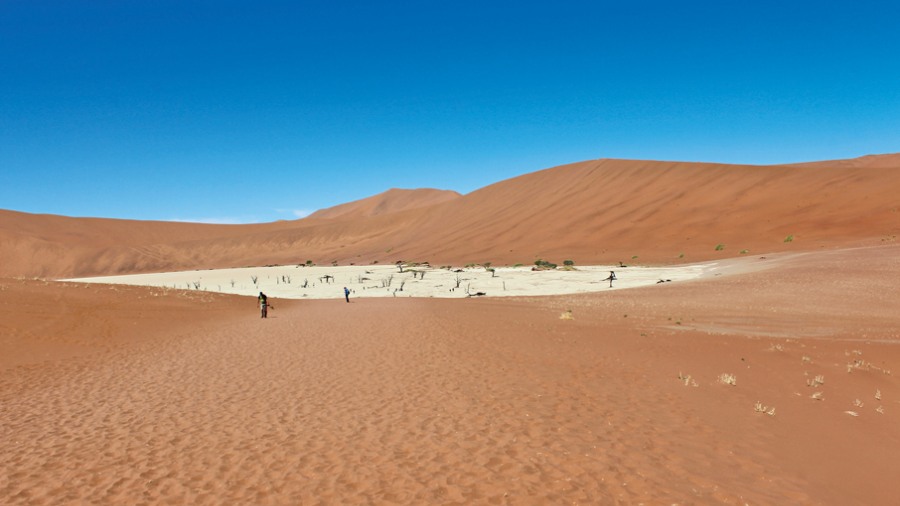The chief operating officer of my life announced one morning that we will be going to Namibia for our next holiday. Like most men who have been married for a while and struggle to hide their ignorance about most worldly matters, I nodded in silence. To be honest, I had no idea that Namibia is one of the most prized holiday destinations in our planet.
I had first heard of Namibia, strangely, due to Angelina Jolie. She and Brad Pitt had decided to go to Namibia for Ms Jolie’s childbirth. The next time Namibia registered in my consciousness was when I read the memoirs of John Simpson, a BBC correspondent, about how the government in Namibia was trying to restrict the movement of nomadic tribes and wanted them to settle down in one place.
For thousands of years, nomads were nomads and his account of the conflict of imposing ‘modernity’ on ancient cultural practices and lifestyles, stayed with me. But that was all. I had no other knowledge about this spectacular country which is in southern part of Africa and has South Africa, Botswana and Angola as neighbouring countries.

A lion devouring its kill at Etosha National Park
Unusual choice?
Why Namibia? It is definitely not within the list of first-visit countries for safaris. Most people who travel to Namibia have been to Africa before, but that should not make anyone desist from choosing it as the first African country one can visit. In fact, for tourists, Namibia offers much more than South Africa, Kenya or Tanzania. For others, if one has been on an African safari before and loved it, Namibia has to be the next destination.
In my opinion, Namibia betters other African destinations. Where else will you see the world’s oldest desert, Namib, in kaleidoscopic colours?
Their most famous national park, Etosha, has watering holes just across the lodges. So apart from the usual and customary twice daily safari trips, you get a chance to sit across the water holes whenever you wish to and marvel at the sightings. This is unique, compared to other African safaris we have experienced. The wonder of seeing a variety of animals visiting the watering holes at sunset and at night were rivetting and magical. We saw elephants, rhinos, hyenas, giraffes, springboks coming and going.
Then there is the epic Skeleton Coast. You will drive for hundreds of miles, in the aptly named Skeleton Coast, and not see a soul. The landscape of this place will make one feel humble about the ferocity of nature. To add to it, the seal colony at the Atlantic coast and the chance of interacting with one the last remaining nomadic tribes in our world, the Himbas, are powerful influencers in making us want to go there again.
Namibia contains a combination of cultures, landscapes, and species unlike anywhere else on Earth. At times, the landscape evokes a post-apocalyptic wasteland. We were simply awestruck.
It is one of the most sparsely populated countries in the world. At three people per square kilometre, it has a population of just above 2.5 million and is twice the size of Germany. To put it in context, Namibia has approximately the same density of population as Leh and Ladakh. Namibia is also one of the driest countries in the planet and the landscape is a constant reminder of it.
During our trip, we drove for 3,400km over 12 days in a four-wheel drive, staying at different lodges for a night or two each. And we did not need to honk even once while driving!

Many of the places to stay in game reserves are close to watering holes and one can spot animals like elephant and giraffe easily.
Political backdrop
Namibia is a newly independent country. Before its independence, it was part of South Africa and was known as South West Africa. The Germans occupied the country prior to South Africa. Germany claimed the entire country as a colony in 1884 but surrendered the country to the South African forces fighting on the Allied side during World War I.
Then South Africa was given a League of Nations mandate to administer the territory. In 1978, a United Nations resolution to revoke that mandate failed and South Africa held on to Namibia for another 10 years. A bitter and bloody bush war with Namibian freedom fighters — mostly belonging to the Ovambo tribe — under the political leadership of South West African People’s Organization (Swapo) raged until Namibia finally won its independence on March 21, 1990, after 106 years of foreign rule.
There was apartheid under the South African rule in Namibia, a fact which influenced the population distribution of the country. Different tribes were mandated to live without the liberty of movement in different parts of the country by the South African government. There was forced repatriation of non-whites to different parts of Namibia, which even caused large tracts of Etosha National Park to be taken over and given to the authorities to force resettlement. The wretchedness of the history of colonisation lies below the surface of tranquility and peace in present-day Namibia.

The brass tacks
Now some basic facts. First and foremost, it is a very safe country. If you have double vaccination for Covid, one does not need any further tests. Our travel agent or the Internet did not mention that you need yellow fever vaccine for travelling to Namibia, but that was the first thing we were asked in immigration control when we landed. Fortunately, we were carrying them.
The major international airport is their capital city, Windhoek. Most holiday trips start from there if you are flying into the country. Self-drive and camping trips are very popular in Namibia. The bulk of their tourists are from South Africa followed by Germans and other Europeans. We did not have any difficulty in communicating in English, unlike Pantanal, Brazil, where language was a problem.
Visa applications are pretty straightforward. We got ours in less than two weeks. The main tourist season coincides with South African school holidays when prices are higher. Rainy seasons (November — April) are best avoided because road conditions deteriorate and animal sightings become rarer as they do not travel to seek water.
Our entire trip was planned by my wife through her online research. We made bookings and payments in end-2019 to travel in April 2020 but life and pandemic happened. We travelled finally in September 2022. She chose a local (Namibian) travel agent. Significant amounts of money were transferred in advance and, to be honest, it could have all gone wrong, but everything worked like clockwork.
We arrived at Windhoek, the capital of Namibia one weekday afternoon. I could see about five other aircraft only in the entire airport! We were met by Markus, who would be our guide and driver for next 12 days for the cross-country trip through this wildly desolate and inaccessible country. We were the first ‘Indian Indians’ to have travelled with this agency. Their earlier Indian clients were an Indian family based in California. The agency has been in operation for 22 years. Markus was mightily relieved when he found out that we do eat meat!

An oryx in the desert
Erindi Game Reserve
We drove from the airport to our first stop, Erindi Game Reserve. It is a private game reserve. Our guide mentioned that some cheetahs from there have been transported to India. Old Traveler’s Lodge is the place to stay in Erindi and many rooms have waterholes outside the balcony. The dining room has a magnificent viewing deck across a large and busy waterhole. We saw cheetahs, hippos, crocodiles, rhinos, elephants, giraffes amongst other animals in Erindi.
During our dinner at Old Traveler’s Lodge, we figured that vegetarians will have a really limited number of options in Namibia. This fact was evident during our entire trip. So, for those who are vegetarians, informing the lodges or the travel agent in advance is mandatory. For meat eaters, there is an eye-popping range of different meats — kudu, wildebeest, oryx, springboks and warthogs, apart from the other standard non-vegetarian fare, were commonly served in buffets.

The desert is a riot of hues through the day
Etosha National Park
Our next stop after Erindi was Etosha National Park. It is THE park for game viewing in Namibia. The name Etosha comes from Oshindonga word meaning ‘Great White Place’ referring to the Etosha salt pan. Oshindonga is the commonest language spoken in Namibia. The Etosha Pan is a vast, bare, open expanse of shimmering green and white that covers almost a quarter of the beautiful Etosha National Park.
At 130km long and up to 50km wide in places, it is comfortably the largest salt pan in Africa and is the park’s most distinctive and dramatic feature. The Internet claims it is visible even from space! The pan was originally a lake but over time the earth’s climate forced the rivers that once fed the lake to change course and flow into the Atlantic Ocean.
The pan adds to the richness of experience of travelling in Etosha. The dryness, the sparse vegetation and thousands of zebras, oryxes and springboks grazing the landscape adds a surreal quality to the safaris. It is a very different experience compared to safaris in South Africa, Kenya or Tanzania. The white sandy hue as the landscape and backdrop in Etosha is distinct from the savannahs of Masai Mara, Serengeti or Kruger.
The other key distinctive feature of visiting Etosha is the hushed wonder of seeing animals visiting the waterholes. The waterholes are strategically located around the lodges, with comfortable and ample viewing seats available. You can sit there as long as you want to immerse yourself in observing animal behaviour. We saw groups of rhinos intimidating each other, rhinos being cautious around herds of elephants and hyenas furtively attempting to drink water, without much success.
There are two different kinds of accommodation available in Etosha National Park. The ones located inside the park are government-owned and have the advantage of manmade waterholes being adjacent to them. The private lodges are outside the park and are more expensive but more luxurious. Etosha is a very large park with a very varied terrain, fauna and animal population. It is larger than Masai Mara and Serengeti.
There are five different government lodges located at different parts of the park and one has to stay in at least two, or, ideally, three in order to grasp the varied beauty of the park.

Flamingoes by the hundreds
Damaraland
From Etosha, which is in the northwest part of the country, we now started travelling south. Our next stop was a beautiful and pristine lodge in a region known as Damaraland. The name comes from a semi-nomadic tribe called Damara or Bergdama that was found to be living there in 17th and 18th centuries.
Namibia is often called the ‘Land God Made in Anger’ because of its stark and spectacular landscapes and untamed wilderness. One of the places it is apparent is in Damaraland. The fascinating rock formations and rugged deserted mountains is jaw dropping in beauty. The fierce beauty of nature has to be imbibed in silence, which is all-pervading in this place.
Damaraland reminded me of Ladakh, but Ladakh on steroids! The range of colour, the absolute absence of any sign of human civilisation and the prospect of seeing endangered species such as desert lions and black rhinos will keep it etched in our memories. There are many places in the world where we feel that photographs are hopelessly inadequate to capture the canvas on which God has painted his/her creations. The landscape in Damaraland is one such place. Photographs cannot ever do justice to it.

Tents for tourists in the Namib Desert. No photo can ever capture the vastness and desolation of the place.
The Skeleton Coast
From Damaraland we continued our southward journey to the most written and visited places in Namibia. The entire western part of the country is a coastline against the Atlantic Ocean. The northern part of this coastline in known as Skeleton Coast, which merges into the famed Namib Nakulft Desert in the southern part.
Travelling along Skeleton Coast, the title felt apt. The untamed Skeleton Coast begins at Namibia’s northern border with Angola and continues 300 miles south to the former German colonial town of Swakopmund. This is the second largest town in Namibia, where strudel-filled bakeries and beer gardens still line the streets. It is here that a century ago, thousands of Africans from two ethnic groups, the Herero and the Nama, were killed by German soldiers. Parts of Mad Max were shot here and apparently a song sequence of Dhoom 2!
The wildness, the desolation, the inaccessible mystery of Skeleton Coast lit up our imagination. The gates of Skeleton Coast National Park, near the Ugab River, were guarded by twin skull and crossbones and towering whale ribs. The objects served as apt warning! This arid desert dead-ends into violent Atlantic swells that have caused many unfortunate sailors, ships, aircraft and animals their untimely deaths. Their carcasses — rusting vessels, sun-bleached bones — are now visible reminders of the park’s hostile conditions.
It is an inhospitable place where almost nothing grows, and where dangers, from wild rip curls to thick coastal fog, abound. Visitors are drawn to the park’s shipwreck-dotted coastline. The Skeleton Coast has witnessed the wreckage of 14 major ships since 1914. Though only a few are still visible, hundreds of vessels have met their fates along this span of shore and were slowly devoured by the elements.
It is the sweeping dunes cascading into the ocean that people travel from all over the world to see. In the sunlight, they look magnificent, their flaxen peaks rising into the bright blue sky.
We drove for four hours and hardly saw another soul. Just eerie, lunar nothingness stretching south to the horizon. To the left, desert; to the right, ocean. A packed salt road sewed a tight seam between the two. Under an overcast sky, the three surfaces faded into a single indistinguishable gray-brown smear. It was nothing but surreal.

The telling entrance to the Skeleton Coast National Park
Cape Cross seal colony
At the end of our day’s journey, we arrived at Cape Cross. The Portuguese were the first Europeans to land in Namibia and they landed here. The reason for visiting Cape Cross is to see one of the largest seal colonies in the world. About 200,000 seals reside here. It is a sight to behold.
Then there are massive salt pans that are coloured bright pink by the presence of Dunaliella salina microorganisms. Matching flamingoes stalked prawns in the nearby wetlands. Makeshift tables lined the road and resting on them were dozens of light pink halite salt crystals, often accompanied by rusted money boxes, lying in wait for honest passers-by to leave a few bucks in exchange for a treasure.
Next morning after visiting the seal colony, we headed further south. We travelled through Walvis Bay, where thousands of flamingos were wading in the lagoon, their flashy fuchsia brightening the sunset.

Cape Cross seal colony
The Namib Desert
The coastline and colours slowly changed, the sand reddening, as we headed further south and entered the Namib-Naukluft National Park, home to the world’s oldest desert: the Namib.
The young country’s namesake, the Namib has existed for at least 55 million years, its towering dunes plunging for eons into the churning sea. That one desert can be red, pink, orange, brown and grey in different parts was unknown to us. We spent two days at the desert. We saw it during sunrise, from a helicopter, during mid-day and during sunset.
We went on a stomach-churning dune-bashing ride and stopped to drink champagne on top of a dune, which was directly falling into the Atlantic Ocean.
The next morning at 7am we hopped into a tiny helicopter that had no doors! It was more like a tiny chariot, open on two sides, with a propeller on top. The ride was exhilarating and scary at the same time.
This one-hour ride over the red desert during sunrise is something which will be etched in our memories. Words are inadequate to describe what we saw. The undulating geometrical sand dunes of myriad colours, the play of shadows against the contours of sand, groups of oryxes running across the dunes, against a rising sun, will be the lasting images of our trip. It is for this single beguiling frame, sunlight galvanising the shades of red, orange and brown sand dunes of the vast Namib Desert, one can justify a trip to Namibia.

The Deadvlei
But there were more wonders in store. After the helicopter ride we went back to our beautiful lodge and had breakfast. It was time to head for the famed dunes of the Namib and Deadvlei by car. Deadvlei is a desiccated clay pan, or “dead marsh”. It is a sprawling expanse of petrified white earth studded with carcasses of acacia trees crisped into charcoal stumps. The white pan is surrounded by a red/orange desert on all sides. The contrast is remarkable, and the effect is macabre and surreal, like a Dalí painting come to life — except it’s utterly devoid of life.
The road to Deadvlei is beautiful. The mandatory stops are two famous red sand dunes, Dune 45 and Big Daddy. We climbed parts of the Dune 45 but strong winds literally were blowing us away. Hence, we abandoned the idea of climbing to the top of Dune 45. It is so named because it is 45km form the park gate. Having the right footwear is mandatory for dune climbing. Just wearing socks is also good enough as sand invariably enters the shoes and makes them heavier.
From Deadvlei, we travelled back to Windhoek the next day, where our trip ended.
Namibia reminded me of a lecture by Carl Sagan. He refers to our planet as a ‘pale blue dot’ in the cosmos. He refers to Earth as ‘mote of dust, suspended on a sunbeam’ and reminds us about our insignificance and ‘the folly of human conceit’ but in the best of ways. Like many other places in this planet, Namibia is grand, spectacular — and humbling.
Pictures by J.R. Ram and Sreemoyee Sen Ram
Dr Jai Ranjan Ram is a senior consultant psychiatrist and co-founder of Mental Health Foundation (www.mhfkolkata.com). Find him on Facebook @Jai R Ram
